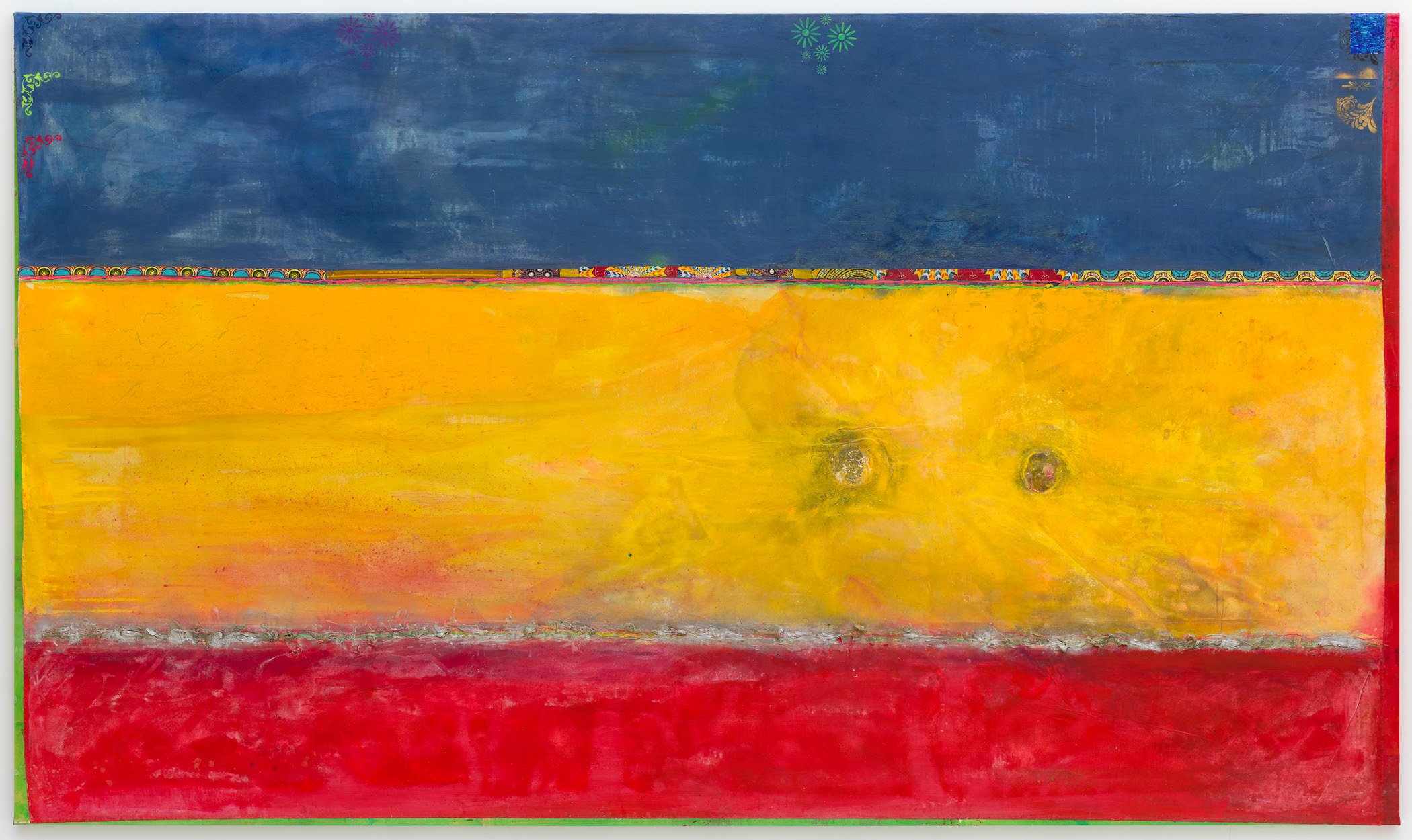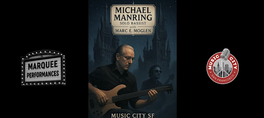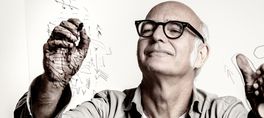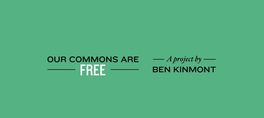Frank Bowling: The New York Years 1966-1975, the first major U.S. survey of the artist's work in more than four decades. Co-organized with the Museum of Fine Arts Boston, this exhibition captures the significance of the formative decade when Bowling, who was born in British Guiana (now Guyana), moved from London to New York. Featuring over 40 color-soaked paintings, this exhibition uncovers the explosive development of his vision and practice during a period that continues to inflect his deeply experimental works today. The SFMOMA exhibition adds to the Museum of Fine Arts Boston's presentation Frank Bowling's Americas with nine additional artworks, including an expanded group of recent paintings produced between 2018 and 2020. The San Francisco presentation also features a wide selection of archival materials that emphasize Bowling's evolution as an artist, incorporating recorded interviews in New York and London, film footage and photographs from Bowling's 1968 visit to Guyana, as well as a selection of his little-known "map" sketches. The exhibition is accompanied by a richly illustrated catalogue and will be on view through September 10, 2023.
A companion gallery highlights artists from Bowling's international circle. It includes New York-based artists featured in 5+1, the groundbreaking 1969 exhibition Bowling curated, such as Jack Whitten, Melvin Edwards and Daniel LaRue Johnson, as well as peers and interlocutors on both sides of the Atlantic such as Francis Bacon, Larry Rivers, Jasper Johns, Sam Gilliam and Alma Thomas. Visitors have a chance to see Bowling's work alongside his fellow visionary contemporaries, showing his voice as a curator, critic and important figure in debates around process-based abstraction and the role of Black cultural identity in artistic practices. By connecting his work to that of his peers', threads of influence can be traced to and from Bowling and the other artists.
"We are looking forward to engaging our communities with the exceptional work of Frank Bowling and to offering an in-depth exploration of the enduring influence of his time in New York, both on his own work and on the development of art more broadly," said Christopher Bedford, the Helen and Charles Schwab Director at SFMOMA. "In particular, the presentation of the 5+1 exhibition provides an opportunity to experience Bowling as a scholar and teacher committed to elevating the voices of Black artists and expanding the understanding of art history as it unfolded. This very much aligns with our institutional vision to share significant, if perhaps lesser-known, facets of artists' careers and to explore artistic achievement through a spectrum of lenses and perspectives."
Organized loosely chronologically, 43 paintings across nine thematic galleries trace the major bodies of work Bowling produced in New York when he lived at the famous Hotel Chelsea before moving to his studio at 535 Broadway. It opens with works made on canvases brought to New York from London with silkscreened images of his mother's storefront, Bowling's Variety Store, in New Amsterdam, Guyana. A suite of galleries contain Bowling's celebrated "map paintings" with hazy outlines of continents within oceanic fields of color that explore overlapping personal, political and modernist histories. Featuring expansive works measuring up to 20-feet wide such as Penumbra (1970), the exhibition also includes False Start (1967), Barticaborn I (1967) and Traveling with Robert Hughes (1969-70) shown only at SFMOMA, highlighting Bowling's stunning range of techniques including stencils, thin washes of color, spray painted outlines and silkscreened images.
Later galleries explore Bowling's engagement with abstraction from colorful compositions that reflect watery landscapes from Guyana, London and New York to his technically pioneering studio processes. His "poured paintings," made using a tilting platform to spill layers of acrylic paint from different heights, exemplify the depth of the artist's experimentation. Rosebush (1974), featuring a deep red background with brilliant drips of yellow, green and pink; and Iceni (1975), incorporating deep tones of green mixed over pale pinks and yellows, reflect this technique. Both paintings are exclusive to the SFMOMA exhibition. The unpredictability of the paint layers makes for dynamic and materially rich canvases.
The many influences of Bowling's time in New York shine through in the work he continues to produce today, exemplified in paintings like SFMOMA's Elder Sun Benjamin (2018), Looking West Again (2020) and 4 Bensusi (2020), each of which integrate vivid layers of paint along with references to family histories and personal and studio materials. These works resonate with the artist's deep legacy of experimentation while incorporating the elements of inspiration he found in New York.
"Building on SFMOMA's major recent acquisition of Bowling's Elder Sun Benjamin (2018), this exhibition features luminous and groundbreaking works that uncover the complexity and richness of Bowling's formative years in New York," said Marin Sarvé-Tarr, Assistant Curator of Painting and Sculpture. "It shows his lasting impact on debates around representation, abstraction and cross-cultural contributions to global histories of art from the 20th century to today."
ABOUT FRANK BOWLING
Born in colonial British Guiana (now Guyana) in 1934, Bowling moved to London in 1953 to complete his education, winning a scholarship to London's Royal College of Art in 1959. Steeped in the British Pop movement early on, Bowling began traveling to the U.S. in 1961 and visited Guyana in 1962 before settling in New York in 1966. Over the course of the next decade, his work pushed the boundaries between abstraction and figuration in grand scale paintings that incorporate layered and sewn canvases, silkscreened and stenciled imagery and vibrant fields of color. Bowling held several teaching appointments, wrote copiously for important art journals, exhibited widely and curated 5+1, an historically significant exhibition of five leading African American abstract artists plus Bowling himself at the Art Gallery of Stony Brook University, New York. While his primary residence in the U.S. concluded in 1975, Bowling still maintains studios in London and New York.
Image credit: Frank Bowling, Elder Sun Benjamin, 2018; San Francisco Museum of Modern Art, purchase by exchange, through a gift of Peggy Guggenheim; © Frank Bowling; photo: Katherine Du Tiel
show less
A companion gallery highlights artists from Bowling's international circle. It includes New York-based artists featured in 5+1, the groundbreaking 1969 exhibition Bowling curated, such as Jack Whitten, Melvin Edwards and Daniel LaRue Johnson, as well as peers and interlocutors on both sides of the Atlantic such as Francis Bacon, Larry Rivers, Jasper Johns, Sam Gilliam and Alma Thomas. Visitors have a chance to see Bowling's work alongside his fellow visionary contemporaries, showing his voice as a curator, critic and important figure in debates around process-based abstraction and the role of Black cultural identity in artistic practices. By connecting his work to that of his peers', threads of influence can be traced to and from Bowling and the other artists.
"We are looking forward to engaging our communities with the exceptional work of Frank Bowling and to offering an in-depth exploration of the enduring influence of his time in New York, both on his own work and on the development of art more broadly," said Christopher Bedford, the Helen and Charles Schwab Director at SFMOMA. "In particular, the presentation of the 5+1 exhibition provides an opportunity to experience Bowling as a scholar and teacher committed to elevating the voices of Black artists and expanding the understanding of art history as it unfolded. This very much aligns with our institutional vision to share significant, if perhaps lesser-known, facets of artists' careers and to explore artistic achievement through a spectrum of lenses and perspectives."
Organized loosely chronologically, 43 paintings across nine thematic galleries trace the major bodies of work Bowling produced in New York when he lived at the famous Hotel Chelsea before moving to his studio at 535 Broadway. It opens with works made on canvases brought to New York from London with silkscreened images of his mother's storefront, Bowling's Variety Store, in New Amsterdam, Guyana. A suite of galleries contain Bowling's celebrated "map paintings" with hazy outlines of continents within oceanic fields of color that explore overlapping personal, political and modernist histories. Featuring expansive works measuring up to 20-feet wide such as Penumbra (1970), the exhibition also includes False Start (1967), Barticaborn I (1967) and Traveling with Robert Hughes (1969-70) shown only at SFMOMA, highlighting Bowling's stunning range of techniques including stencils, thin washes of color, spray painted outlines and silkscreened images.
Later galleries explore Bowling's engagement with abstraction from colorful compositions that reflect watery landscapes from Guyana, London and New York to his technically pioneering studio processes. His "poured paintings," made using a tilting platform to spill layers of acrylic paint from different heights, exemplify the depth of the artist's experimentation. Rosebush (1974), featuring a deep red background with brilliant drips of yellow, green and pink; and Iceni (1975), incorporating deep tones of green mixed over pale pinks and yellows, reflect this technique. Both paintings are exclusive to the SFMOMA exhibition. The unpredictability of the paint layers makes for dynamic and materially rich canvases.
The many influences of Bowling's time in New York shine through in the work he continues to produce today, exemplified in paintings like SFMOMA's Elder Sun Benjamin (2018), Looking West Again (2020) and 4 Bensusi (2020), each of which integrate vivid layers of paint along with references to family histories and personal and studio materials. These works resonate with the artist's deep legacy of experimentation while incorporating the elements of inspiration he found in New York.
"Building on SFMOMA's major recent acquisition of Bowling's Elder Sun Benjamin (2018), this exhibition features luminous and groundbreaking works that uncover the complexity and richness of Bowling's formative years in New York," said Marin Sarvé-Tarr, Assistant Curator of Painting and Sculpture. "It shows his lasting impact on debates around representation, abstraction and cross-cultural contributions to global histories of art from the 20th century to today."
ABOUT FRANK BOWLING
Born in colonial British Guiana (now Guyana) in 1934, Bowling moved to London in 1953 to complete his education, winning a scholarship to London's Royal College of Art in 1959. Steeped in the British Pop movement early on, Bowling began traveling to the U.S. in 1961 and visited Guyana in 1962 before settling in New York in 1966. Over the course of the next decade, his work pushed the boundaries between abstraction and figuration in grand scale paintings that incorporate layered and sewn canvases, silkscreened and stenciled imagery and vibrant fields of color. Bowling held several teaching appointments, wrote copiously for important art journals, exhibited widely and curated 5+1, an historically significant exhibition of five leading African American abstract artists plus Bowling himself at the Art Gallery of Stony Brook University, New York. While his primary residence in the U.S. concluded in 1975, Bowling still maintains studios in London and New York.
Image credit: Frank Bowling, Elder Sun Benjamin, 2018; San Francisco Museum of Modern Art, purchase by exchange, through a gift of Peggy Guggenheim; © Frank Bowling; photo: Katherine Du Tiel
Frank Bowling: The New York Years 1966-1975, the first major U.S. survey of the artist's work in more than four decades. Co-organized with the Museum of Fine Arts Boston, this exhibition captures the significance of the formative decade when Bowling, who was born in British Guiana (now Guyana), moved from London to New York. Featuring over 40 color-soaked paintings, this exhibition uncovers the explosive development of his vision and practice during a period that continues to inflect his deeply experimental works today. The SFMOMA exhibition adds to the Museum of Fine Arts Boston's presentation Frank Bowling's Americas with nine additional artworks, including an expanded group of recent paintings produced between 2018 and 2020. The San Francisco presentation also features a wide selection of archival materials that emphasize Bowling's evolution as an artist, incorporating recorded interviews in New York and London, film footage and photographs from Bowling's 1968 visit to Guyana, as well as a selection of his little-known "map" sketches. The exhibition is accompanied by a richly illustrated catalogue and will be on view through September 10, 2023.
A companion gallery highlights artists from Bowling's international circle. It includes New York-based artists featured in 5+1, the groundbreaking 1969 exhibition Bowling curated, such as Jack Whitten, Melvin Edwards and Daniel LaRue Johnson, as well as peers and interlocutors on both sides of the Atlantic such as Francis Bacon, Larry Rivers, Jasper Johns, Sam Gilliam and Alma Thomas. Visitors have a chance to see Bowling's work alongside his fellow visionary contemporaries, showing his voice as a curator, critic and important figure in debates around process-based abstraction and the role of Black cultural identity in artistic practices. By connecting his work to that of his peers', threads of influence can be traced to and from Bowling and the other artists.
"We are looking forward to engaging our communities with the exceptional work of Frank Bowling and to offering an in-depth exploration of the enduring influence of his time in New York, both on his own work and on the development of art more broadly," said Christopher Bedford, the Helen and Charles Schwab Director at SFMOMA. "In particular, the presentation of the 5+1 exhibition provides an opportunity to experience Bowling as a scholar and teacher committed to elevating the voices of Black artists and expanding the understanding of art history as it unfolded. This very much aligns with our institutional vision to share significant, if perhaps lesser-known, facets of artists' careers and to explore artistic achievement through a spectrum of lenses and perspectives."
Organized loosely chronologically, 43 paintings across nine thematic galleries trace the major bodies of work Bowling produced in New York when he lived at the famous Hotel Chelsea before moving to his studio at 535 Broadway. It opens with works made on canvases brought to New York from London with silkscreened images of his mother's storefront, Bowling's Variety Store, in New Amsterdam, Guyana. A suite of galleries contain Bowling's celebrated "map paintings" with hazy outlines of continents within oceanic fields of color that explore overlapping personal, political and modernist histories. Featuring expansive works measuring up to 20-feet wide such as Penumbra (1970), the exhibition also includes False Start (1967), Barticaborn I (1967) and Traveling with Robert Hughes (1969-70) shown only at SFMOMA, highlighting Bowling's stunning range of techniques including stencils, thin washes of color, spray painted outlines and silkscreened images.
Later galleries explore Bowling's engagement with abstraction from colorful compositions that reflect watery landscapes from Guyana, London and New York to his technically pioneering studio processes. His "poured paintings," made using a tilting platform to spill layers of acrylic paint from different heights, exemplify the depth of the artist's experimentation. Rosebush (1974), featuring a deep red background with brilliant drips of yellow, green and pink; and Iceni (1975), incorporating deep tones of green mixed over pale pinks and yellows, reflect this technique. Both paintings are exclusive to the SFMOMA exhibition. The unpredictability of the paint layers makes for dynamic and materially rich canvases.
The many influences of Bowling's time in New York shine through in the work he continues to produce today, exemplified in paintings like SFMOMA's Elder Sun Benjamin (2018), Looking West Again (2020) and 4 Bensusi (2020), each of which integrate vivid layers of paint along with references to family histories and personal and studio materials. These works resonate with the artist's deep legacy of experimentation while incorporating the elements of inspiration he found in New York.
"Building on SFMOMA's major recent acquisition of Bowling's Elder Sun Benjamin (2018), this exhibition features luminous and groundbreaking works that uncover the complexity and richness of Bowling's formative years in New York," said Marin Sarvé-Tarr, Assistant Curator of Painting and Sculpture. "It shows his lasting impact on debates around representation, abstraction and cross-cultural contributions to global histories of art from the 20th century to today."
ABOUT FRANK BOWLING
Born in colonial British Guiana (now Guyana) in 1934, Bowling moved to London in 1953 to complete his education, winning a scholarship to London's Royal College of Art in 1959. Steeped in the British Pop movement early on, Bowling began traveling to the U.S. in 1961 and visited Guyana in 1962 before settling in New York in 1966. Over the course of the next decade, his work pushed the boundaries between abstraction and figuration in grand scale paintings that incorporate layered and sewn canvases, silkscreened and stenciled imagery and vibrant fields of color. Bowling held several teaching appointments, wrote copiously for important art journals, exhibited widely and curated 5+1, an historically significant exhibition of five leading African American abstract artists plus Bowling himself at the Art Gallery of Stony Brook University, New York. While his primary residence in the U.S. concluded in 1975, Bowling still maintains studios in London and New York.
Image credit: Frank Bowling, Elder Sun Benjamin, 2018; San Francisco Museum of Modern Art, purchase by exchange, through a gift of Peggy Guggenheim; © Frank Bowling; photo: Katherine Du Tiel
read more
A companion gallery highlights artists from Bowling's international circle. It includes New York-based artists featured in 5+1, the groundbreaking 1969 exhibition Bowling curated, such as Jack Whitten, Melvin Edwards and Daniel LaRue Johnson, as well as peers and interlocutors on both sides of the Atlantic such as Francis Bacon, Larry Rivers, Jasper Johns, Sam Gilliam and Alma Thomas. Visitors have a chance to see Bowling's work alongside his fellow visionary contemporaries, showing his voice as a curator, critic and important figure in debates around process-based abstraction and the role of Black cultural identity in artistic practices. By connecting his work to that of his peers', threads of influence can be traced to and from Bowling and the other artists.
"We are looking forward to engaging our communities with the exceptional work of Frank Bowling and to offering an in-depth exploration of the enduring influence of his time in New York, both on his own work and on the development of art more broadly," said Christopher Bedford, the Helen and Charles Schwab Director at SFMOMA. "In particular, the presentation of the 5+1 exhibition provides an opportunity to experience Bowling as a scholar and teacher committed to elevating the voices of Black artists and expanding the understanding of art history as it unfolded. This very much aligns with our institutional vision to share significant, if perhaps lesser-known, facets of artists' careers and to explore artistic achievement through a spectrum of lenses and perspectives."
Organized loosely chronologically, 43 paintings across nine thematic galleries trace the major bodies of work Bowling produced in New York when he lived at the famous Hotel Chelsea before moving to his studio at 535 Broadway. It opens with works made on canvases brought to New York from London with silkscreened images of his mother's storefront, Bowling's Variety Store, in New Amsterdam, Guyana. A suite of galleries contain Bowling's celebrated "map paintings" with hazy outlines of continents within oceanic fields of color that explore overlapping personal, political and modernist histories. Featuring expansive works measuring up to 20-feet wide such as Penumbra (1970), the exhibition also includes False Start (1967), Barticaborn I (1967) and Traveling with Robert Hughes (1969-70) shown only at SFMOMA, highlighting Bowling's stunning range of techniques including stencils, thin washes of color, spray painted outlines and silkscreened images.
Later galleries explore Bowling's engagement with abstraction from colorful compositions that reflect watery landscapes from Guyana, London and New York to his technically pioneering studio processes. His "poured paintings," made using a tilting platform to spill layers of acrylic paint from different heights, exemplify the depth of the artist's experimentation. Rosebush (1974), featuring a deep red background with brilliant drips of yellow, green and pink; and Iceni (1975), incorporating deep tones of green mixed over pale pinks and yellows, reflect this technique. Both paintings are exclusive to the SFMOMA exhibition. The unpredictability of the paint layers makes for dynamic and materially rich canvases.
The many influences of Bowling's time in New York shine through in the work he continues to produce today, exemplified in paintings like SFMOMA's Elder Sun Benjamin (2018), Looking West Again (2020) and 4 Bensusi (2020), each of which integrate vivid layers of paint along with references to family histories and personal and studio materials. These works resonate with the artist's deep legacy of experimentation while incorporating the elements of inspiration he found in New York.
"Building on SFMOMA's major recent acquisition of Bowling's Elder Sun Benjamin (2018), this exhibition features luminous and groundbreaking works that uncover the complexity and richness of Bowling's formative years in New York," said Marin Sarvé-Tarr, Assistant Curator of Painting and Sculpture. "It shows his lasting impact on debates around representation, abstraction and cross-cultural contributions to global histories of art from the 20th century to today."
ABOUT FRANK BOWLING
Born in colonial British Guiana (now Guyana) in 1934, Bowling moved to London in 1953 to complete his education, winning a scholarship to London's Royal College of Art in 1959. Steeped in the British Pop movement early on, Bowling began traveling to the U.S. in 1961 and visited Guyana in 1962 before settling in New York in 1966. Over the course of the next decade, his work pushed the boundaries between abstraction and figuration in grand scale paintings that incorporate layered and sewn canvases, silkscreened and stenciled imagery and vibrant fields of color. Bowling held several teaching appointments, wrote copiously for important art journals, exhibited widely and curated 5+1, an historically significant exhibition of five leading African American abstract artists plus Bowling himself at the Art Gallery of Stony Brook University, New York. While his primary residence in the U.S. concluded in 1975, Bowling still maintains studios in London and New York.
Image credit: Frank Bowling, Elder Sun Benjamin, 2018; San Francisco Museum of Modern Art, purchase by exchange, through a gift of Peggy Guggenheim; © Frank Bowling; photo: Katherine Du Tiel
show less
Date/Times:
SFMOMA
118 Upcoming Events
151 3rd Street, San Francisco, CA 94103
The Best Events
Every Week in Your Inbox
From Our Sponsors
UPCOMING EVENTS
Great suggestion! We'll be in touch.
Event reviewed successfully.









